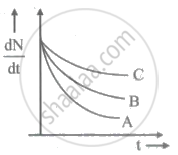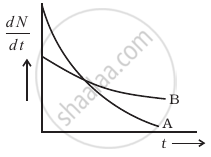Advertisements
Advertisements
प्रश्न
Two different radioactive elements with half lives T1 and T2 have N1 and N2 undecayed atoms respectively present at a given instant. Derive an expression for the ratio of their activities at this instant in terms of N1 and N2 ?
उत्तर
Activity for a radioactive substance is given as
\[A = \frac{d N}{d t} = \lambda N = \frac{0 . 693N}{T}\]
\[ \therefore A_1 = \frac{0 . 693 N_1}{T_1}; A_2 = \frac{0 . 693 N_2}{T_2}\]
\[ \Rightarrow \frac{A_1}{A_2} = \frac{N_1}{T_1} \times \frac{T_2}{N_2}\]
\[ \Rightarrow \frac{A_1}{A_2} = \frac{N_1}{N_2} \times \frac{T_2}{T_1}\]
APPEARS IN
संबंधित प्रश्न
Write symbolically the process expressing the β+ decay of `""_11^22Na`. Also write the basic nuclear process underlying this decay.
Represent Radioactive Decay curve using relation `N = N_o e^(-lambdat)` graphically
A radioactive element disintegrates for an interval of time equal to its mean lifetime. The fraction that has disintegrated is ______
Which one of the following nuclei has shorter meant life?

'Half-life' of a radioactive substance accounts for ______.
After 1 hour, `(1/8)^"th"` of the initial mass of a certain radioactive isotope remains undecayed. The half-life of the isotopes is ______.
Two radioactive materials Y1 and Y2 have decay constants '5`lambda`' and `lambda` respectively. Initially they have same number of nuclei. After time 't', the ratio of number of nuclei of Y1 to that of Y2 is `1/"e"`, then 't' is equal to ______.
What percentage of radioactive substance is left after five half-lives?
The variation of decay rate of two radioactive samples A and B with time is shown in figure.

Which of the following statements are true?
- Decay constant of A is greater than that of B, hence A always decays faster than B.
- Decay constant of B is greater than that of A but its decay rate is always smaller than that of A.
- Decay constant of A is greater than that of B but it does not always decay faster than B.
- Decay constant of B is smaller than that of A but still its decay rate becomes equal to that of A at a later instant.
A piece of wood from the ruins of an ancient building was found to have a 14C activity of 12 disintegrations per minute per gram of its carbon content. The 14C activity of the living wood is 16 disintegrations per minute per gram. How long ago did the tree, from which the wooden sample came, die? Given half-life of 14C is 5760 years.
